
30 years ago much-maligned climate models showed wet areas getting wetter, dry areas getting even drier into the 21st century. It’s amazing to see theory showing up on a daily basis on the weather maps.
If exceptional drought continues there’s talk of another potential Dust Bowl for the southern Plains, hopefully not on a scale like the 1930s – the worst long-term environmental catastrophe to impact the USA. California is facing water shortages and another severe wildfire season, which pretty much runs year-round now. Meanwhile the Balkans just experienced 3 months of rain in 3 days, with historic flooding and mudslides.
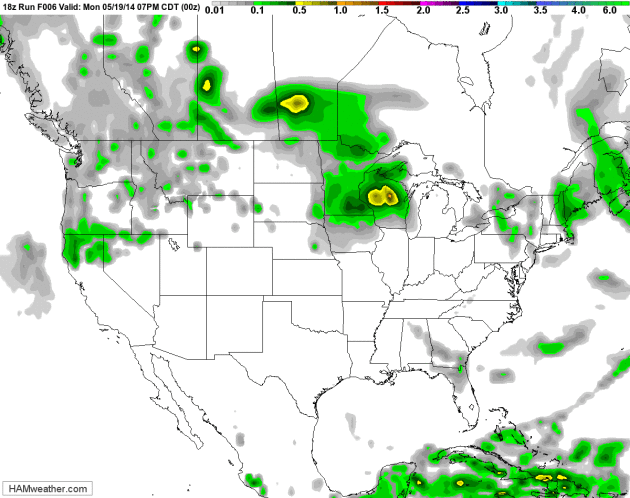
GFS Solution. Showers and T-storms push across the Midwest and Great Lakes today, a (rare) western storm pushing a few showers into California and Nevada. By late week a strong southerly flow from the Gulf of Mexico sparks heavy showers and storm over the Plains (including drought-plagued counties from Texas to Kansas); heavy T-storms reaching Minnesota and the Upper Midwest by Sunday and Monday. Source: NOAA and HAMweather.
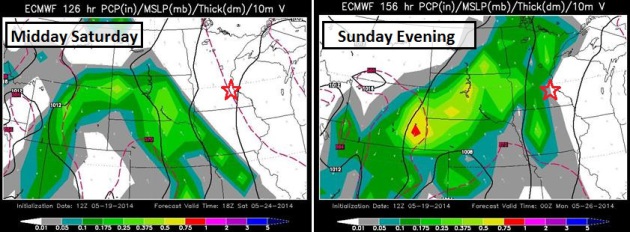
ECMWF Guidance. The European model keeps showers and T-storms south and west of Minnesota Saturday; probably the best day for the lake with highs near 80F. By Sunday heavy T-storms rumble across the state, a better chance of storms in the Alexandria and Brainerd lakes area than the Twin Cities. With any luck it will be scattered (heavy) T-storms, and not a series of all-day wash-outs Sunday and Monday. Source: WSI Corporation.
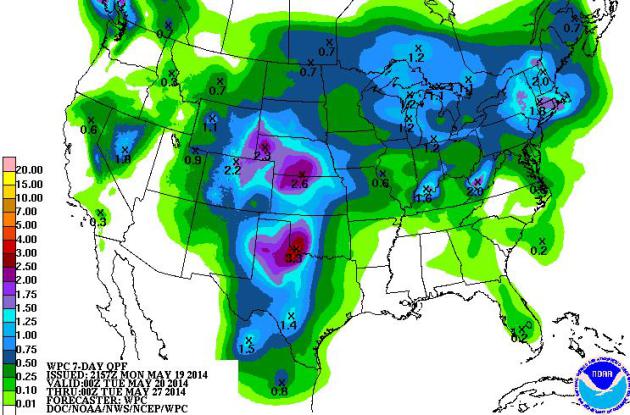
Hopeful Outlook for Southern Plains. Considering much of Kansas, Oklahoma, Texas and New Mexico is now in exceptional drought, the 7-Day Rainfall Outlook above is encouraging, showing some 1-3″ amounts from near San Antonio to Oklahoma City, Wichita and Lincoln. Dry weather is predicted for the Gulf Coast and far southwestern USA. Source: NOAA.
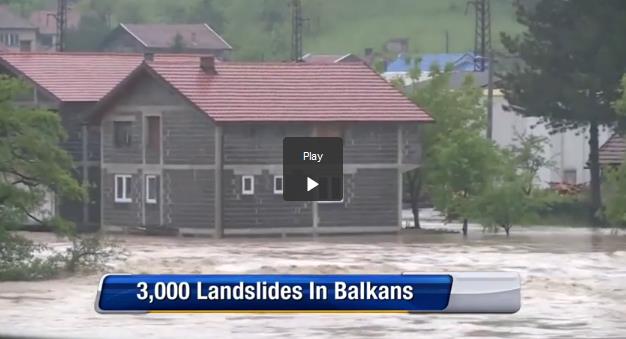
Floods in Balkans Trigger More Than 3,000 Landslides. It’s the worst flooding on record for much of the Balkans, including Bosnia and Croatia. Here’s a video clip fromnews4jax.com.
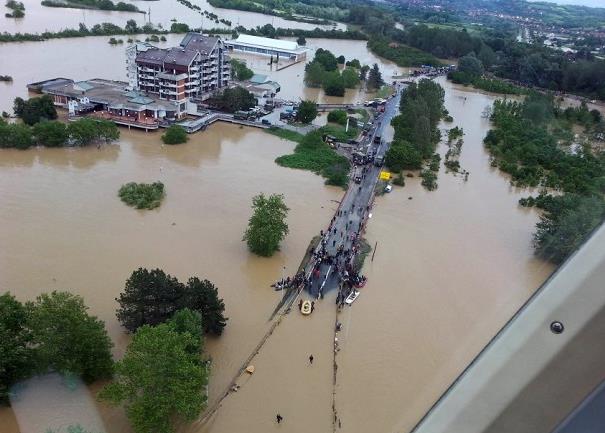
Flood in the Balkans – Driving Landmines To The Surface. National Turk has the story – here’s the introduction: “Dozens of people have already fallen to the flood victims in the Balkans. Now facing a new danger: landmines from the civil war of the 90s are free and floating. Several cities are under water, dozens of people were killed in the floods. The Balkans is fighting against devastating floods. Now the flood landmines from the war in Bosnia rinsed free. Several exploded already...”

Could We See Another Dust Bowl? The odds are small, but not zero. Although a widespread catastrophe similar to the 1930s is unlikely, a smaller-scale, regional disaster is possible over the southern Plains, where the ongoing drought has reached “exceptional” criteria. It’s already one of the 5 worst droughts for Texas in the last 500 years, according to the state climatologist. All it takes is a few major storms to start whipping around dust and topsoil. At the rate we’re going with one extreme after another, nothing would surprise me. Here’s a recap of today’s Climate Matters: “WeatherNationTV Chief Meteorologist Paul Douglas looks back at the Dust Bowl and compares it to the historic drought currently impacting the Southern Plains. What are the chances of it happening again?“
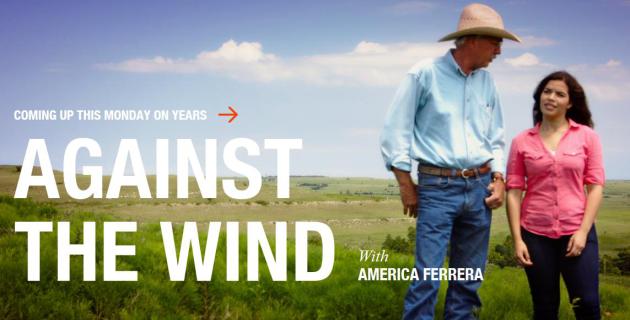
“…A drought is like a piece of sand you can never get out of your eye. It’s always there, it always reminds you every day, when you look out and see the landscape…dying…” – from “Years of Living Dangerously” on Showtime.

Humans Cause Vast Majority of Wildfires Nationally. This story at azfamily.com had some interesting statistics; here’s the introduction: “More than 72,600 wildfires are reported in the U.S. each year. Humans are the primary cause of fires and start roughly six times more blazes than lightning strikes in a given year, according to the National Interagency Fire Center in Boise, Idaho, which tracked fire causes between 2001 and 2013. Human-caused fires burn more than 2. 5 million acres each year, or nearly 4,000 square miles – an area bigger than Delaware…”
Image credit: MGN Online.
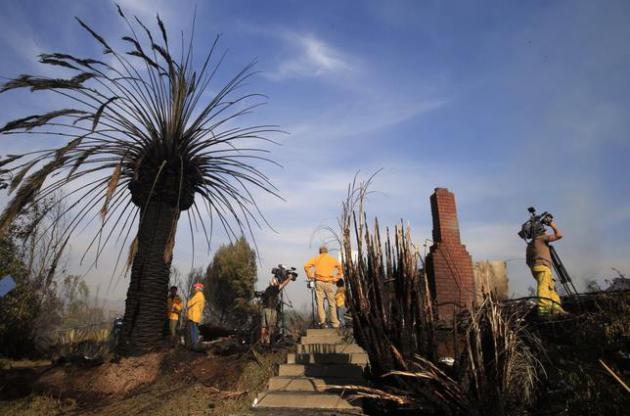
California Governor Prepares For Worst Wildfire Season. AP and Financial Expresshave the story; here’s a clip: “Drought-stricken California is preparing for its worst wildfire season ever, the state’s governor said Sunday. Gov. Jerry Brown told ABC television’s ”This Week” that the nearly dozen wildfires that caused more than $20 million in damage mark only the beginning. The state has 5,000 firefighters and has appropriated $600 million to battling blazes, but that may not be enough in the future…”
Photo credit above: “News media converge on a destroyed home on Mount Whitney Road in Escondido, Calif., on Friday, May 16, 2014.” (Mark Boster/Los Angeles Times/MCT).
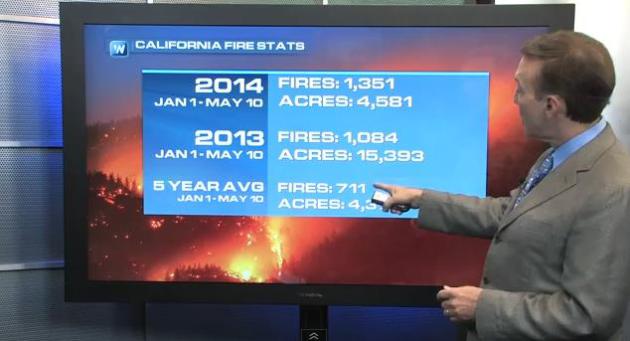
People Are 6 Times More Likely To Start Wildfires Than Lightning. Every year an area roughly the size of Delaware goes up in smoke. So far 2014 has brought nearly twice as many wildfires than 2013, to date, on track for a potentially record-setting fire season. Details in today’s second edition of Climate Matters: “Humans are 6 times more likely to cause a wildfire compared to lightning. Either accidental or intentional, its going to be a long and dry fire season across the Southwest. WeatherNationTV Chief Meteorologist Paul Douglas goes over the forecast conditions for the drought stricken western states. Is there a change ahead?“
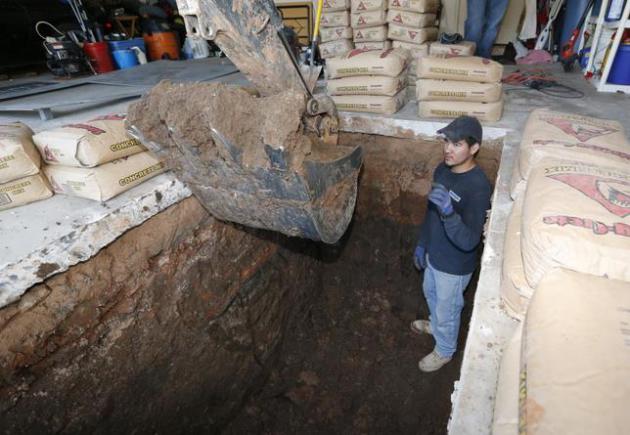
Shelter From The Storm: Schools Build Tornado Safe Rooms. The Joplin EF-5 resulted in school districts finding the money necessary to reinforce (new) schools going up, a trend which will be catching on not only in traditional Tornado Alley, but vulnerable communities east of the Mississippi. Here’s a clip from an interesting article atWRCBtv.com in Chattanooga: “…But Joplin’s devastation didn’t just create traumatic memories; it was also the impetus for overhauling southwest Missouri’s disaster preparedness. Christian County, which includes Nixa, has been particularly aggressive in pursuing FEMA grants to build tornado-safe rooms in schools. Two Nixa schools already have safe rooms, and three more are planned or are under construction. Nixa was the first in the area to have shelters in schools—the first ones were operational less than two years after the 2011 Joplin tornado—and were the first to post their building plans online. There’s a new project underway to install all new tornado-safe external doors in the schools. Other communities, including Joplin, have looked to Nixa for ideas…”
Photo credit above: “In this Thursday, May 1, 2014 photo, Jacob Ortiz, of Thunderground Storm Shelters, directs as the finishing touches are put on a hole for a storm shelter installation in the garage of a residence in Oklahoma City. Last year’s deadly tornadoes, which killed more than 30 people, scared Oklahomans in a way that previous storms had not, moving them to add tornado shelters or reinforced safe rooms to their homes. In fact, surging demand has overwhelmed companies that build the shelters.” (AP Photo/Sue Ogrocki).
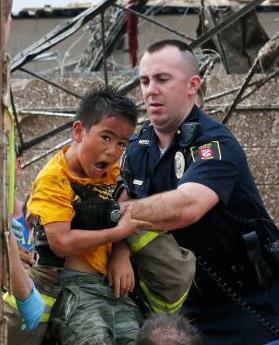
Fears Linger for Students Who Faced Deadly Tornado. A weather-version of PTSD? I see it all the time with survivors who’ve experienced a weather-related trauma. And there can be no bigger trauma than an EF-5 tornado. Here’s an excerpt from The Houston Chronicle: “...Even the slightest turn in the weather can cause anxiety and fear for the surviving Plaza Towers students, who have been attending classes at a refurbished junior high since the storm, Principal Amy Simpson said. “We try not to say ‘tornado’ around here,” said Simpson, who rode out the storm with five other staffers in a small bathroom. “Just the word scares them.” Even the continuous outpouring of cards, gifts and well wishes from students across the country brings fresh reminders. “The hardest part about that is that the kids are reminded each time someone gives something to us that their friends are gone,” she said…”
Photo credit above: “Sue Ogrocki/AP. “In this May 20, 2013 file photo, Kai Heuangpraseuth is pulled from beneath a collapsed wall at the Plaza Towers Elementary School following a tornado in Moore, Okla. Heuangpraseuth will return to a new Plaza Towers Elementary in the fall, built on the same spot where seven of his schoolmates died last year during the storm.”

How To Build A School to Withstand a Tornado. Here’s a video from NBC News that shows how focused spending on safe rooms and reinforced hallways can lower the risk of death and injury: “Taking lessons from last year’s deadly Moore, Okla., tornado, officials are trying to determine how to better erect buildings.”

Researcher Uses Past Oklahoma Tornado To Predict Future. Are tornadoes, especially large/violent tornadoes, more likely to take specific tracks, hitting the same communities repeatedly over time? Is there such a thing as “favored tracks”, or is it a statistical coincidence? One researcher in Oklahoma set out to leverage GIS tools to try and answer this question. Here’s an excerpt of a story (and video) from NewsOn6.com in Tulsa: “…After the 2013 Moore tornado, Pendergrass stepped up his analysis of Oklahoma tornados. Looking at tornado data for every square mile of the state back to 1950, his study shows the probability of an area being hit by a twister any given year is 1 in 1,000. But he says the calculations show it’s much higher in certain areas. “There’s enough history to say these areas are going to be hit repeatedly,” Pendergrass said. The study shows the worst spots, a 1 in 100 probability, include paths from Newcastle to Moore to Harrah, and from Drumright to Skiatook. Those are level one areas, because the tornados, based on the past, are also likely to be EF-4 or EF-5s…”
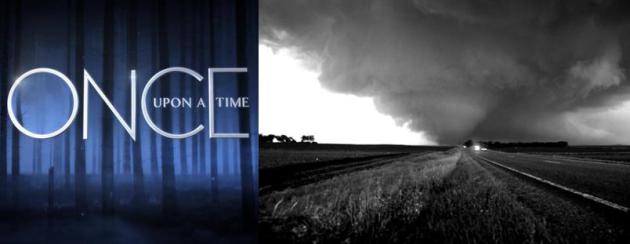
Tornadoes Win Out Over TV Fairy Tales. Viewers complaining about tornado warnings that don’t impact their neighborhoods? I definitely feel the pain of the local (Sioux Falls, South Dakota) TV meteorologist who was trying to do the right thing, “serve the public interest” and narrate an ongoing tornado threat. It all comes down to relevancy and personalization – at some point new technology will allow only the TV/cable/satellites boxes in the path of a tornado to activate, so the rest of us can continue to blissfully watch “Once Upon a Time” and not be bothered. Here’s an excerpt from The Spectrum: “There’s one constant in the news business that just about every journalist has to learn at some point for themselves: There’s simply no way to make everyone happy.How extreme can it get? We saw an example in the past couple of weeks thanks to a fierce storm in South Dakota. As a tornado touched down in Hospers, Iowa, about 70 miles from Sioux Falls, South Dakota, the ABC affiliate there broke into programming to warn people to take cover. Apparently, a few of the viewers took real exception to that strategy because they missed the final moments of their favorite program, “Once Upon A Time...”

Wyoming Supercell. Yes, this looks like an alien landscape, like something you might find on one of the moons of Jupiter. Boston.com has the story, and remarkable YouTube footage.
Tsunami Conspiracy Theories in the Caribbean. From climate conspiracies to tsunami conspiracies, the black helicopter crowd is positive information is being covered up. Here’s a clip from an eye-opening story at scidev.net: “As soon as I arrived at last week’s meeting on tsunami science here in the Caribbean, I encountered two delegates who shared a worrying rumour with me: “Somebody knows something about a tsunami that’s coming soon.” That’s the way rumors work: with ill-defined but arresting claims like this one. As usual, the rumour is based on a (distorted) reality. The last major tsunami in the Caribbean hit in 1918 — killing 40 people and causing US$40 million worth of damage — and because the earthquakes that cause tsunamis sometimes adhere to decades-long cycles, some scientists here think that another one must be due…”
Image credit: Espen Rasmussen / Panos.
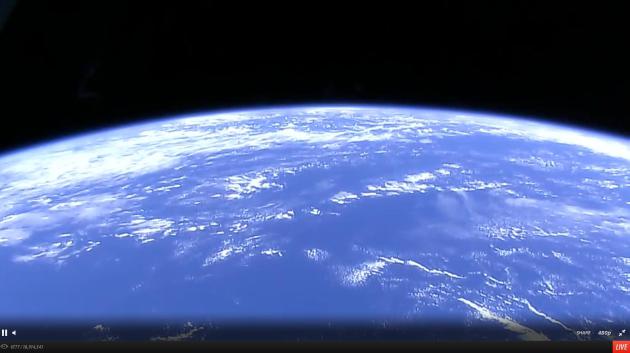
HDEV Allows Us Detailed Views Of Our Planet From Space. One of the few remaining (must-attempt) things on my bucket list is to get into low-Earth orbit. I’m hoping the prices come down in the coming years and I won’t need to sell a kidney to see weather (from above). In the meantime gizmag.com has a story about a near real-time stream of HD video coming from NASA’s ISS, the International Space Station. Here’s a clip: “As of April 30, NASA has been running its High Definition Earth Viewing Experiment (HDEV) which, as well as testing certain aspects such as a camera’s ability to survive the radiation levels present in low-Earth orbit, is giving viewers the breathtaking experience of observing their planet in exquisite detail from space. The video feed is streamed from one of four high-definition cameras mounted on fixed positions of the Columbus External Payload Facility of the ISS…”
* the live stream from NASA is here, courtesy of UStream.
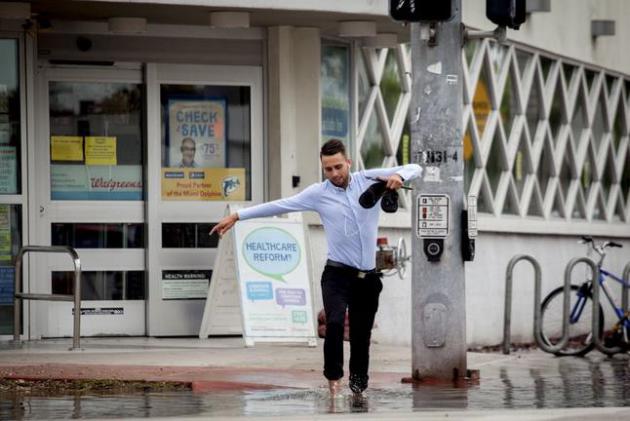
The People of Miami Know About Climate Change. We’re Living It. You no longer need a hurricane or even a coastal storm or thunderstorm downpours to get flooding in Miami. Now it often floods at high tide, a rising tide at that. Here’s an excerpt from a story at The Guardian: “…People in Miami Beach are living climate change,” said David Nolan, a meteorology and physical oceanography professor at the University of Miami. “They’re on the frontline.” The people of Miami Beach didn’t need the National Climate Assessment to tell them low-lying south Florida is “exceptionally vulnerable to sea level rise”. The city is already spending $206m to overhaul its drainage system. The day after the White House released its climate change report, Miami-Dade County’s commission passed a 6 May resolution that calls on planners to account for sea level rise. Local officials across the four counties of south Florida are making similar moves. Almost anyone who lives in south Florida has a nagging fear about climate change. It’s both abstract and, at times, very real…”
Photo credit above: “Bozon Jeremie, a tourist from France, crosses a flooded intersection during high tide in Miami Beach, Fla., Nov. 6, 2013. A new scientific report on global warming released in 2014 by the National Climate Assessment named Miami as one of the cities most vulnerable to severe damage as a result of rising sea levels.” (Angel Valentin/The New York Times).

Global Warming Responsible for Increased Wildfires in California? If this is, in fact, a “natural cycle” it’s one heck of a coincidence. Here’s an excerpt from a story atHeadline & Global News: “…Global warming also contributes largely to mega-fires, which occur when multiple wildfires combine together to form a larger, deadlier blaze, and the size of these fires makes it difficult for containment. In the last decade, the occurrence of such fires has increased in frequency. According to Global Change, about 6.4 million acres have been burned per year on an average since 2010, amounting to a 3.5 million acres increase since the 1980s. Many studies have also highlighted that global warming also increases wildfires indirectly. This climate change leads to other factors that promote wildfires, such as drought and insect outbreaks…”
File Photo credit: “Smoke plumes rise behind the Marine Corps Camp Pendleton entrance Friday, May 16, 2014, in Oceanside, Calif. San Diego County officials said Friday five wildfires have been 100 percent contained. Still, crews were focusing efforts on two large fires — one in the city of San Marcos and two blazes at the Marine Corps’ Camp Pendleton.” (AP Photo/Gregory Bull).
_______________________________________________________________________________
Welcome to the WeatherNation blog. Every day I sift through hundreds of stories, maps, graphics and meteorological web sites, trying to capture some of the most interesting weather nuggets, the stories behind the forecast. I’ll link to stories and share some of the web sites I use. I’m still passionate about the weather, have been ever since Tropical Storm Agnes flooded my home in Lancaster, PA in 1972. I’ve started 5 weather-related companies. “EarthWatch” created the world’s first 3-D weather graphics for TV stations – Steven Spielberg used our software in “Jurassic Park” and “Twister”. My last company, “Digital Cyclone”, personalized weather for cell phones. “My-Cast” was launched in 2001 and is still going strong on iPhone, Android and Blackberry. I sold DCI to Garmin in 2007 so I could focus on my latest venture: WeatherNation. I also write a daily weather column for The Star Tribune startribune.

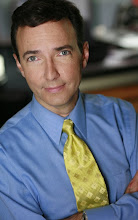
not only is the lack of rain in the southwest disheartening, but the aging population is shifting that way, moving to warmer climes, many year round. The increased demand on water is not helping the water shortage. Also, the increased want to have green lawns and swimming pools in that area. Really? It’s a desert! I think water rationing should be strongly encouraged!!